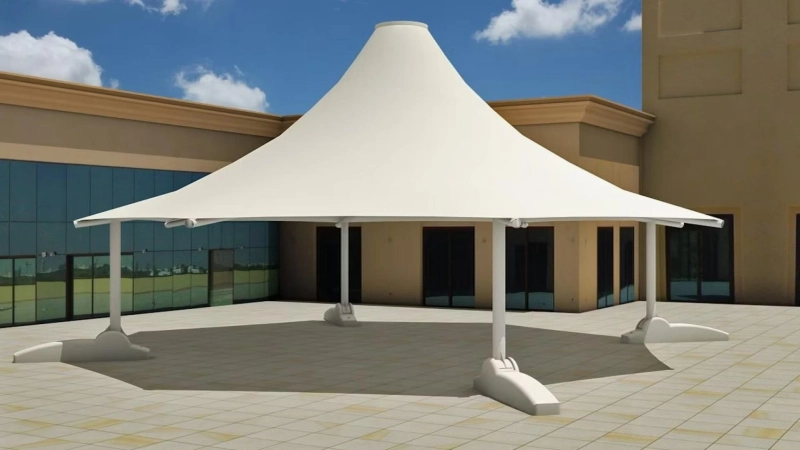Tent structures are popular for temporary shelters, events, and even semi-permanent buildings due to their flexibility and cost-effectiveness. However, they come with several disadvantages that can affect their usability, durability, and overall performance. Understanding these drawbacks helps in making informed decisions before choosing a tent structure for any purpose.
Limited Durability and Weather Resistance
One of the biggest disadvantages of tent structures is their limited durability compared to permanent buildings. Most tents are made from lightweight fabrics or thin materials that are not designed to withstand extreme weather conditions. Heavy rain, strong winds, or snow accumulation can cause damage, leading to leaks, tears, or even complete collapse.
Unlike solid structures, tents do not provide the same level of insulation. In cold climates, they can become very chilly, while in hot weather, they may trap heat, making the interior uncomfortable. Even high-quality tent materials degrade over time due to prolonged exposure to sunlight, moisture, and temperature fluctuations, reducing their lifespan.
Poor Security and Privacy
Tent structures generally offer weak security compared to traditional buildings. The fabric walls are easy to cut or break into, making them unsuitable for storing valuable items or providing secure shelter. Additionally, tents often lack solid doors and locks, increasing the risk of theft or unauthorized access.
Privacy is another concern, as many tent materials are thin and semi-transparent. Even with liners or additional layers, sound travels easily through tent walls, making it difficult to maintain confidentiality in business or personal settings. For events or living spaces, this lack of privacy can be a significant drawback.
High Maintenance and Repair Costs
While tents may seem affordable initially, they often require frequent maintenance and repairs. Fabric can tear, zippers may break, and metal or plastic frames can bend or crack under stress. Replacing damaged parts or entire sections can become costly over time, especially if the tent is used frequently or in harsh conditions.
Mold and mildew are common problems in tents that are not properly dried after rain or high humidity. These issues not only weaken the material but can also create health hazards. Regular cleaning and proper storage are necessary to prolong the tent’s life, adding to the overall maintenance burden.
Limited Structural Stability
Tents are not as stable as permanent structures, especially in windy or stormy conditions. Even with sturdy frames and anchoring systems, strong gusts can lift or shift the entire structure. This instability makes them risky for long-term use in areas prone to severe weather.
Additionally, tents are not suitable for heavy loads. Unlike solid roofs, tent coverings cannot support significant weight, meaning they cannot handle snow buildup or be used for storage overhead. This limitation restricts their functionality in certain environments and applications.
Short Lifespan Compared to Permanent Buildings
While some high-end tents are designed for semi-permanent use, most tent structures have a much shorter lifespan than traditional buildings. Constant exposure to the elements causes wear and tear, fading, and material breakdown. Even with proper care, a tent will eventually need replacement, whereas a well-built permanent structure can last decades.
For businesses or individuals looking for a long-term solution, the recurring cost of replacing tents can outweigh the initial savings. This makes tents a less economical choice over extended periods compared to more durable alternatives.
Lack of Customization and Rigidity
Tent structures often lack the customization options available in traditional construction. While some modular designs allow for adjustments, most tents have fixed shapes and limited interior layout possibilities. This can be a problem for businesses or homeowners who need specific configurations for their space.
Additionally, tents do not provide the same rigid structure as buildings, meaning they cannot support heavy fixtures, shelving, or complex electrical setups. This limitation affects their suitability for certain commercial or residential uses where stability and customization are essential.
Difficulty in Meeting Building Codes
In many regions, tent structures do not meet standard building codes for permanent habitation or commercial use. Fire safety, insulation, and structural integrity requirements are often stricter for traditional buildings, making tents unsuitable for long-term occupancy in regulated areas.
Event organizers may also face permit challenges when using large tents for public gatherings, as local authorities often impose restrictions due to safety concerns. This can lead to additional costs for reinforcements or even denial of permits, complicating event planning.
Environmental Impact
Although tents are often seen as a temporary and low-impact solution, their environmental footprint can be significant. Many tents are made from synthetic materials that are not biodegradable, contributing to waste when they are discarded. Frequent replacements due to wear and tear also increase material consumption and landfill waste.
Additionally, heating or cooling a tent is less energy-efficient than climate-controlling a well-insulated building. The lack of proper insulation means more energy is required to maintain comfortable temperatures, leading to higher carbon emissions over time.
Conclusion
While tent structures offer flexibility and affordability for short-term use, they come with several disadvantages that limit their practicality for long-term or heavy-duty applications. Poor durability, weak security, high maintenance, and instability in harsh weather are major concerns. Additionally, their short lifespan, lack of customization, and difficulty in meeting building codes make them less ideal compared to permanent structures.
For those considering a tent structure, weighing these drawbacks against the intended use is crucial. In cases where temporary, lightweight shelter is sufficient, tents may still be a viable option. However, for more permanent or secure needs, alternative solutions may be necessary.



